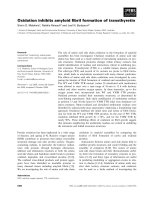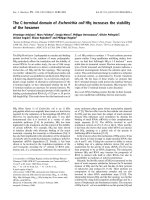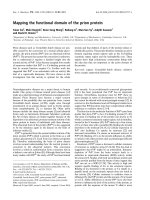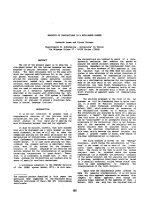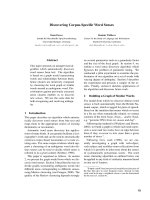Báo cáo khoa học: "Extraposition via Complex Domain Formation*" pot
Bạn đang xem bản rút gọn của tài liệu. Xem và tải ngay bản đầy đủ của tài liệu tại đây (525.84 KB, 7 trang )
Extraposition via Complex Domain Formation*
Andreas Kathol and Carl Pollard
Dept. of Linguistics
, 1712 Neil Ave.
Ohio State University
Columbus, OH 43210, USA
{kathol, pollard}©ling, ohio-stat e. edu
Abstract
We propose a novel approach to extraposi-
tion in German within an alternative con-
ception of syntax in which syntactic struc-
ture and linear order are mediated not via
encodings of hierarchical relations but in-
stead via order domains. At the heart of
our proposal is a new kind of domain for-
mation which affords analyses of extrapo-
sition constructions that are linguistically
more adequate than those previously sug-
gested in the literature.
1 Linearization without phrase
structure
Recent years have seen proposals for the elimina-
tion of the phrase structure component in syntax in
favor of levels of representation encompassing possi-
bly nonconcatenative modes of serialization (Dowty,
In press; Reape, 1993; Reape, 1994; Pollard et al.,
1993). Instead of deriving the string representation
from the yield of the tree encoding the syntactic
structure of that sentence (as, for instance in GPSG,
LFG, and as far as the relationship between S-
structure and PF, discounting operations at PF, is
concerned GB), these proposals suggest deriving
the sentential string via a recursive process that op-
erates directly on encodings of the constituent order
of the subconstituents of the sentence. In Reape's
proposal, which constitutes an extension of HPSG
(Pollard and Sag, 1994), this information is con-
tained in "(Word) Order Domains". On the other
hand, the way that the surface representation is put
together, i.e. the categories that have contributed
to the ultimate string and the grammatical depen-
dency relations (head-argument, head-adjunct, etc.)
holding among them, will be called the "composi-
tion structure" of that sentence, represented below
by means of unordered trees.
*Thanks to Bob Kasper for helpful discussions and
suggestions.
As an example, consider how a German V1 sen-
tence, e.g. a question or conditional clause, is derived
in such a system. 1
(1) Las Karl dasBuch
read Karl the book
E.g.: 'Did Karl read the book?'
The representation in Figure 1 involves a number
of order domains along the head projection of the
clause ([1]-[3]). Each time two categories are com-
bined, a new domain is formed from the domains
of the daughters of that node, given as a list value
for the feature DOM. While the nodes in the deriva-
tion correspond to
signs
in the HPSG sort hierarchy
(Pollard and Sag, 1994), the elements in the order
domains, which we will refer to as
domain objects,
will minimally contain categorial and phonological
information (the latter given in italics within angled
brackets). The value of the DOM attribute thus con-
sists of a list of domain objects. Ordering is achieved
via linear precedence (LP) statements.
In Reape's approach, there are in essence two ways
in which a sign's DOM value can be integrated into
that of its mother. When combining with its ver-
bal head, a nominal argument such as
das Buch
in
Figure 1 in general gives rise to a
single
domain ele-
ment, which is "opaque" in the sense that adjacency
relations holding within it cannot be disturbed by
subsequent intervention of other domain objects. In
contrast, some constituents contribute the contents
of their order domains wholesale into the mother's
domain. Thus, in Figure 1, both elements of the VP
([2]) domain become part of the higher clausal ([1])
domain. As a result, order domains allow elements
that are not sisters in composition structure to be
linearly ordered with respect to each other, contrary
1In Kathol and Pollard (1995), we argue for dispens-
ing with binary-valued features such
as
INV(ERTED) or
EXTRA(POSED) in favor of a multi-valued single feature
TOPO(LOGY) which imposes a partition on the set of do-
main elements of a clause according to membership in
Topological Fields (see also Kathol (In progress)). Since
nothing in the present proposal hinges on this detail, we
keep with the more common binary features.
174
[1]
I
S
V[SUBCAT
O]
DOM/
[ (las) ]
(Karl)
\ Lv[+'NV] ]
[
]
' NP[NOM] '
( das Buch)
rNP[NOM]
[4] [DOM
([(KarO])
]
= V[SUBCAT (NP[NOM])] 1
[2]
/DOM/ [("as) 1 ru,,., B,.,ch)]
\/
L \
Lv[-FINV]j ' t NP[ACC]
]
/J
,.
. . ~ rVrSUB¢~T~' T~rNO~I,
',,,,,,c,,,,,l
,3,
]}
Figure h Derivation of V1 clause using order domains
NP[ACC])]
to ordinary HPSG, but in the spirit of "liberation"
metarules (Zwicky, 1986).
With Reape we assume that one crucial mecha-
nism in the second type of order domain formation is
the
shuffle
relation (Reape's
sequence union),
which
holds of n lists L1, , L,-1, L,, iff
L,
consists of
the elements of the first n-1 lists interleaved in such a
way that the relative order among the original mem-
bers of L1 through L,-1, respectively, is preserved in
Ln.
As a consequence, any precedence (but not ad-
jacency) relations holding of domain elements in one
domain are also required to hold of those elements
in all other order domains that they are members
of, which amounts to a monotonicity constraint on
deriving linear order. Hence, if [1] in Figure 1 were
to be expanded in the subsequent derivation into
a larger domain (for instance by the addition of a
sentential adverb), the relative order of subject and
object in that domain could not be reversed within
the new domain.
The data structure proposed for domains in
Reape (1993) is that of a list of objects of type
sign.
However, it has been argued (Pollard et al., 1993)
that signs contain more information than is desirable
for elements of a domain. Thus, a sign encodes its
internal composition structure via its DAUGHTERS
attribute, while its linear composition is available as
the value of
DOM. Yet,
there are no known LP con-
straints in any language that make reference to these
types of information. We therefore propose an im-
poverished data structure for elements of order do-
mains which only consists of categorial and seman-
tic information (viz. the value of SYNSEM (Pollard
and Sag, 1994)) and a phonological representation.
This means that whenever a constituent is addedto
a domain as a single element, its information con-
tent will be condensed to categorial and phonolog-
ical information. 2 The latter is constrained to be
the concatenation of the PHONOLOGY values of the
domain elements in the corresponding sign's order
2For expository convenience, semantic information is
systematically ignored in this paper.
domain. We will refer to the relation between a sign
S and its representation as a single domain object
O as the
compaction,
given informally in (2): 3
(2) compaction([i-],El )
rsig. ]
53:/sYNSZM if]
LD°"
([PHON [ 4.~], ,[PHON[~)
[ dom-obj ]
A
~: I s,,N~E~,~I~
LPHONI,Io o r-;-I
To express this more formally, let us now define an
auxiliary relation,
joinF,
which holds of two lists
L1 and L2 only if L2 is the concatenation of val-
ues for the feature F of the elements in L1 in the
same order: 4
(3) joinF([Y],[~)
(V]: 0 A [7]: O)
V (cons(IF (El)], [-~-],[~
A joinF([?],[~)
A append([';'],r~,[~]) )
This allows us to define
compaction
more precisely
as in (4):
(4) compaction([-i-],[~) _
[sign
]
~:/sYNSEM ~/
LDOM~ J
r
dom-obj
]
^
~:
I SYNSE~,~ I~I
LPHON sL~ .]
A joinp//oN ([7],[~)
3Here, "o" is a convenient functional notation for the
append relation.
4Here
cons
is the relational analogue of the LISP
function cons; i.e.
cons
holds among some element E
and two lists L1 and L2 only if the insertion of E at the
beginning of L1 yields L2.
175
VP "-" V[SUBCAT (NP)]
]
I
r/,zasBuch)]
>]
DoM j
L D°M ([(das)], [(Buch)])]
[DOM~( [V[+,NV] ] >
A compaction([~],[~])
^ shuffle(q , E], [D
Figure 2: Domain formation using
compaction
and
shuffle
Given
compaction
and the earlier
shnffle
relation,
the construction of the intermediate VP domain can
be thought of as involving an instance of the Head-
Complement Schema (Pollard and Sag, 1994), aug-
mented with the relevant relational constraints on
domain formation, as shown in Figure 2.
2 Extraposition via Order Domains
Order domains provide a natural framework for or-
der variation and discontinuous constituency. One of
the areas in which this approach has found a natural
application is extraposition of various kinds of con-
stituents. Reape (1994) proposes the binary-valued
feature EXTRA to order an extraposed VP last in the
domain of the clause, using the LP statement in (5):
(5) [ EXTRA] "~ [+EXTRA]
Similarly, Nerbonne (1994) uses this feature to
account for instance for extrapositions of relative
clauses from NPs such as (6); the composition struc-
ture proposed by Nerbonne for (6)is given in Fig-
ure 3.
(6)
einen Hund fiittern [der Hunger hat]
a dog feed that hunger has
'feed a dog that is hungry'
The structure in Figure 3 also illustrates the fea-
ture
UNIONED,
which Reape and Nerbonne assume
to play a role in domain formation process. Thus, a
constituent marked
[UNIONED -Jr-]
requires that the
contents of its domain be shuffled into the domain
of a higher constituent that it becomes part of (i.e.
it is
domain-unioned).
For instance, in Figure 3, the
[UNIONED +]
specification on the higher NP occa-
sions the VP domain to comprise not only the verb,
but also both domain objects of the NP. Conversely,
a [UNIONED ]
marking in Reape's and Nerbonne's
system effects the insertion of a single domain ob-
ject, corresponding to the constituent thus specified.
Therefore, in Figure 3, the internal structure of the
relative clause domain becomes opaque once it be-
comes part of the higher NP domain.
3 Shortcomings of Nerbonne's
analysis
One problematic aspect of Nerbonne's proposal con-
cerns the fact that on his account, the extraposabil-
ity of relative clauses is directly linked to the Head-
Adjunct Schema that inter alia licenses the combi-
nation of nominals with relative clauses. However,
whether a clause can be extraposed is independent
of its adjunct/complement status within the NP.
Thus, (7) illdstrates the extraposition of a comple-
ment clause (Keller, 1994):
(7) Planck hat die Entdeckung gemacht
Planck has the discovery made
[dab Licht Teilchennatur hat].
that light particle.nature has
'Planck made the discovery
that light has a particle nature.'
The same also holds for other kinds of extraposable
constituents, such as VPs and PPs. On Nerbonne's
analysis, the extraposability of complements has to
be encoded separately in the schema that licenses
head-complement structures. This misses the gen-
eralization that extraposability of some element is
tied directly to the final occurrence within the con-
stituent it is dislocated from. s Therefore, extrapos-
ability should be tied to the
linear
properties of the
constituent in question, not to its grammatical func-
tion.
A different kind of problem arises in the case of ex-
tractions from prepositional phrases, as for instance
in (S):
(8) an einen Hund denken [der Hunger hat]
of a dog think that hunger has
'think of a dog that is hungry'
On the one hand, there has to be a domain object for
an einen Hund
in the clausal domain because this
SNote that final occurrence is a necessary, but
not sufficient condition. As is noted for instance in
Keller (1994), NP complements (e.g. postnominal geni-
tives) cannot be extraposed out of NPs despite their final
occurrence. We attribute this fact to a general constraint
against extraposed NPs in clauses, except for adverbial
accusative NPs denoting time intervals.
176
VP
oo.( <.r
], ],
)]
~_. I r (einen Hund) ] [ ( der Hunger hat)| ]
"REL-S
UNIONED -
[NP
] EXTRA"~-
DoM ([ (eine.)1, [(Hund)
])
ool,,, (
[<Jet)]
<Hunger)
.
],[<v',O,>])
Figure 3: Extraposition of relative clause in Nerbonne 1994
[VoM
element is subject to the same variations in linear
order as PPs in general. On the other hand, the
attachment site of the preposition will have to be
higher than the relative clause because clearly, the
relative clause modifies the nominal, but
not
the PP.
As a potential solution one may propose to have
the preposition directly be "integrated" (phonologi-
cally and in terms of
SYNSEM
information) into the
NP domain object corresponding to
einen Hund.
However, this would violate an implicit assumption
made in order domain-based approaches to lineariza-
tion to the effect that domain objects are inalterable.
Hence, the only legitimate operations involve adding
elements to an order domain or compacting that do-
main to form a new domain object, but crucially, op-
erations that nonmonotonically change existing do-
main objects within a domain are prohibited.
4 Partial compaction
In this section, we present an alternative to Ner-
bonne's analysis based on an extension of the pos-
sibilities for domain formation. In particular, we
propose that besides total compaction and domain
union, there is a third possibility, which we will call
partial compaction.
In fact, as will become clear be-
low, total compaction and partial compatcion are
not distinct possibilities; rather, the former is a sub-
case of the latter.
Intuitively, partial compaction allows designated
domain objects to be "liberated" into a higher do-
main, while the remaining elements of the source
domain are compacted into a single domain object.
To see how this improves the analysis of extraposi-
tion, consider the alternative analysis for the exam-
ple in (6), given in Figure 4.
As shown in Figure 4, we assume that the or-
der domain within NPs (or PPs) is essentially flat,
and moreover, that domain objects for NP-internal
prenominal constituents are prepended to the do-
main of the nominal projection so that the linear
string is isomorphic to the yield of the usual right-
branching analysis trees for NPs. Adjuncts and
complements, on the other hand, follow the nomi-
nal head by virtue of their
["t-EXTRA]
specification,
which also renders them extraposable. If the NP
combines with a verbal head, it may be partially
compacted. In that case, the relative clause's do-
main object (El) is inserted into the domain of the
VP together with the domain object consisting of
the same
SYNSEM
value as the original NP and that
NP's phonology minus the phonology of the relative
clause ([~]). By virtue of its
[EXTRA "~-]
marking, the
domain object of the relative clause is now ordered
last in the higher VP domain, while the remnant NP
is ordered along the same lines as NPs in general.
One important aspect to note is that on this ap-
proach, the inalterability condition on domain ob-
jects is not violated. Thus, the domain object of
the relative clause ([~ in the NP domain is token-
identical to the one in the VP domain. Moreover,
the integrity of the remaining NP's domain object
is not affected as unlike in Nerbonne's analysis
there is no corresponding domain object in the do-
main of the NP before the latter is licensed as the
complement of the verb
fattern.
In order to allow for the possibility of partially
compacting a domain by replacing the
compaction
relation of (4) by the
p-compaction
relation, which
is defined as follows:
177
I
VP
, IZ]/REL-~
L
EXTRA -4-
[] /r,e,ne.,]
] r' er n,erha"]
DET
[~oM ([(#,,n~)])]
^ p-compaction(l-i-l,[Z], lID)
^ shume(I[Zl), (~,l'q,~
I REL-S
EXTRA
+
v,.\ LR~.'. J' uP
[,:.')])]
Figure 4: Extraposition via partial compaction
(9) p-compaction ([~],[~],[~)
[ sign "1
LDOMIZ]
J
[ dora-oh1 ]
^ [~: 1~_5]1
[PHON 7LT.J J
^ shume(m,[],~
A
joineHoN (~J,[L])
Intuitively, the
p-compaction
relation holds of a sign
S (~]), domain object O ([~, and a list of domain
objects L (~]) only if O is t~-e compaction of S with
L being a llst of domain objects "liberated" from
the S's order domain. This relation is invoked for
instance by the schema combining a head (H) with
a complement (C):
(10) [i~]
[I-I:]
[DOMF~ ]
[C:] []
A p- compaction ([~],~],[~])
^ shume(([~,ff],[E,ff])
^ [B: zist ( [s~NSEM [EXTRA +]])
[ [ HEAD
verb
^([]: <>
v [ :LS'N EM-Lsu. AT
<>]])
The third constraint associated with the Head-
Complement Schema ensures that only those ele-
ments that are marked
as [EXTRA -t-])
within the
smaller constituent can be passed into the higher do-
main, while the last one prevents extraposition out
of clauses (cf. Ross' Right Roof Constraint (Ross,
1967)).
This approach is superior to Nerhonne's, as the
extraposability of an item is correlated onlywith
its linear properties (right-peripheral occurrence in
a domain via [EXTRA +]), but not with its sta-
tus as adjunct or complement. Our approach also
makes the correct prediction that extraposition is
only possible if the extraposed element is already
final in the extraposition source. 6 In this sense, ex-
traposition is subject to a monotonicity condition to
the effect that the element in question has to occur
in the same linear relationship in the smaller and
the larger domains, viz. right-peripherally (modulo
other extraposed constituents). This aspect clearly
favors our approach over alternative proposals that
treat extraposition in terms of a NONLOCAL depen-
dency (Keller, 1994). In approaches of that kind,
there is nothing, for example, to block extraposition
of prenominal elements.
Our approach allows an obvious extension to the
case of extraposition from PPs which are prob-
lematic for Nerbonne's analysis. Prepositions are
prepended to the domain of NPs in the same way
6It should be pointed out that we do not make the as-
sumption, often made in transformational grammar, that
cases in which a complement (of a verb) can only occur
extraposed necessitates the existence of an underlying
non-extraposed structure that is never overtly realized.
178
Iv.
)]
DOM[5-']i [][ (Neienen Hund der ftunger hai) ], [ (vf£Ltteru) ]
]
[
(einen)
[] DoM T ,
A p-compaction(I-F],[], 0)
^ shutne(([~,0 ,[],El)
Figure 5: Total compaction as a special case of compaction
that determiners are to N domains.
Along similar lines, note that extrapositions from
topicalized constituents, noted by Nerbonne as a
challenge for his proposal, do not pose a problem
for our account.
(11) Eine Dame ist an der Tiir
a lady is at the door
[die Sie sprechen will].
who you speak wants
'A lady is at the door
who wants to talk to you.'
If we assume, following Kathol (In progress), that
topicalized constituents are part of the same clausal
domain as the rest of the sentence, 7 then an ex-
traposed domain object, inherited via partial com-
paction from the topic, will automatically have to
occur clause-finally, just as in the case of extraposi-
tion from regular complements.
So far, we have only considered the case in which
the extraposed constituent is inherited by the higher
order domain. However, the definition of the p-
compaction
relation in (12) also holds in the case
where the list of liberated domain objects is empty,
which amounts to the total compaction of the sign
in question. As a result, we can regard total com-
paction as a special case of the
p-compaction
relation
in general. This means that as an alternative lin-
earization of (6), we can also have the extraposition-
less analysis in Figure 5.
Therefore, there is no longer a need for the
UNIONED
feature for extraposition. This means that
we can have a stronger theory as constraints on ex-
traposability will be result of general conditions on
the syntactic licensing schema (e.g. the Right Roof
Constraint in (10)). But this means that whether or
not something can be extraposed has been rendered
exempt from lexical variation in principle unlike in
Reape's system where extraposability is a matter of
lexical selection.
rI.e. the initial placement of a preverbal constituent in
a verb-second clause is a consequence of LP constraints
within a
flat
clausal order domain.
Moreover, while Reape employs this feature for
the linearization of nonfinite complementation, it
can be shown that the Argument Composition
approach of Hinrichs & Nakazawa (Hinrichs and
Nakazawa, 1994), among many others, is linguisti-
cally superior (Kathol, In progress). As a result, we
can dispense with the UNIONED feature altogether
and instead derive linearization conditions from gen-
eral principles of syntactic combination that are not
subject to lexical variation.
5 Conclusion
We have argued for an approach to extraposition
from smaller constituents that pays specific atten-
tion to the
linear
properties of the extraposition
source, s To this end, we have proposed a more fine-
grained typology of ways in which an order domain
can be formed from smaller constituents. Crucially,
we use relational constraints to define the interde-
pendencies; hence our approach fits squarely into the
paradigm in which grammars are viewed as sets of
relational dependencies that has been advocated for
instance in DSrre et al. (1992). Since the relational
perspective also lies at the heart of computational
formalisms such as CUF (DSrre and Eisele, 1991),
the ideas presented here are expected to carry over
into practical systems rather straightforwardly. We
leave this task for future work.
References
Jochen DSrre and Andreas Eisele. 1991. A Compre-
hensive Unification-Based Grammar Formalism.
DYANA Deliverable R3.1.B, ESPRIT Basic Ac-
tion BR3175.
Jochen DSrre, Andreas Eisele, and Roland Seif-
fert. 1992. Grammars as Relational Dependen-
cies. AIMS Report 7, Institut fiir maschinelle
Sprachverarbeitung, Stuttgart.
8 For similar ideas regarding English, see
Stucky (1987).
179
David Dowty. In press. Towards a Minimalist The-
ory of Syntactic Structure. In Horck and Sijtsma,
editors, Discontinuous Constituency. Mouton de
Gruyter.
Erhard Hinrichs and Tsuneko Nakazawa. 1994.
Linearizing finite AUX in German Verbal com-
plexes. In John Nerbonne, Klaus Netter, and Carl
Pollard, editors, German in Head-Driven Phrase
Structure Grammar, pages 11-38. Stanford: CSLI
Publications.
Andreas Kathol and Carl Pollard. 1995. On the
Left Periphery of German Subordinate Clauses.
In West Coast Conference on Formal Linguistics,
volume 14, Stanford University. CSLI Publica-
tions/SLA.
Andreas Kathol. In progress. Linearization-Based
German Syntax. Ph.D. thesis, Ohio State Univer-
sity.
Frank Keller. 1994. Extraposition in HPSG. un-
publ. ms., IBM Germany, Scientific Center Hei-
delberg.
John Nerbonne. 1994. Partial verb phrases and spu-
rious ambiguities. In John Nerbonne, Klaus Net-
ter, and Carl Pollard, editors, German in Head-
Driven Phrase Structure Grammar, pages 109-
150. Stanford: CSLI Publications.
Carl J. Pollard and Ivan A. Sag. 1994. Head-Driven
Phrase Structure Grammar. CSLI Publications
and University of Chicago Press.
Carl Pollard, Robert Levine, and Robert Kasper.
1993. Studies in Constituent Ordering: Toward
a Theory of Linearization in Head-Driven Phrase
Structure Grammar. Grant Proposal to the Na-
tional Science Foundation, Ohio State University.
Mike Reape. 1993. A Formal Theory of Word Or-
der: A Case Study in West Germanic. Ph.D. the-
sis, University of Edinburgh.
Mike Reape. 1994. Domain Union and Word Or-
der Variation in German. In John Nerbonne,
Klaus Netter, and Carl Pollard, editors, German
in Head-Driven Phrase Structure Grammar, pages
151-198. Stanford: CSLI Publications.
John Ross. 1967. Constraints on Variables in Syn-
tax. Ph.D. thesis, MIT.
Susan Stucky. 1987. Configurational Variation
in English: A Study of Extraposition and Re-
lated Matters. In Discontinuous Constituency,
volume 20 of Syntax and Semantics, pages 377-
404. Academic Press, New York.
Arnold Zwicky. 1986. Concatenation and libera-
tion. In Papers from the 22nd Regional Meeting,
Chicago Linguistic Society, pages 65-74.
180


